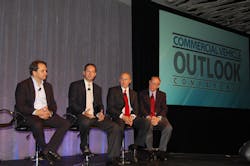DALLAS. The basic equation of total vehicle costs hasn’t changed, but the impact of operating costs in that equation has grown and will continue to grow. That was a fundamental message of a panel discussion on equipment lifecycle trends at the Commercial Vehicle Outlook Conference in Dallas.
What drives total vehicle cost is no mystery, Dave Williams, vice president-equipment for Knight Transportation, told attendees. The equation is simple: Acquisition price + operating costs – residual value = total cost of ownership. What has changed over time is the importance of each factor in that equation.
“Historically, acquisition price and residual value have ruled the day,” Williams said. “Operating costs are a more substantial factor today.”
The truly big operating costs are fuel and downtime, and federal regulations have been game-changers on both, Williams said. The Environmental Protection Agency (EPA) regulations in 2002 and 2007 were nothing but negative in terms of costs: Equipment was more expensive, fuel economy and downtime dropped and residual value dropped.
The 2010 EPA regulations, that equation shifted a bit, Williams said. Acquisition price was still higher, but selective catalytic reduction allowed truck makers to return some of the fuel efficiency lost in 2002 and 2007. It’s too early to prove the impact of EPA10 on residual value, Williams said, although the improved fuel efficiency should help.
The first round of greenhouse gas (GHG) regulations in 2014 also resulted in higher acquisition costs coupled with better fuel economy, Williams noted. Again, a determination on residual costs is premature. California’s own GHG regulations is having the same effect, but the state’s trailer refrigeration unit (TRU) regulation was nothing but bad news financially.
The impact of regulations goes beyond emissions, however, Williams said.
“Many people have a lack of understanding of how the hours-of-service regulations work.” A hard-and-fast 14-hour window for completing work – and, of course, increasing use of technology to enforce it – replaced the old clock in/clock out approach, Williams said. “The value of time has changed dramatically.”
The upshot is that downtime is a greater cost than it had been in the past, making reliability a key concern, Williams said.
These developments have created a real problem for cash-strapped fleets, Williams said. “Capital considerations keeping fleets from refreshing at 1990s rates.” And that means that these fleets are stuck with trucks that are less fuel efficient, less reliable and more costly to maintain.
While vehicle reliability is key, that’s not the only factor in uptime, John Diez, senior vice president of Ryder Dedicated, told CVOC attendees.
Uptime continues to improve, but vehicle complexity creates challenges that dampen the benefits of those improvements, Diez said.
“Complexity of new technology has driven higher maintenance costs and increased down time.” While trucks might break down less often, it might take longer for shops to get those trucks back on the road when they do break down. And complexity adds costs in tooling and training.
“Maintenance is ever-changing,” Diez said. “We run the gamut of major OEM brands and must be in tune with particulars of each OEM platform.” Diez said the next big challenge will be EPA’s 2017 GHG rules. “What maintenance retooling do we need to do?”
Staying on top of vehicle complexity is critical because if drivers and technicians fail to act on warning signals, some of the negative effects include decreased fuel economy, unscheduled downtime and engine de-rating, Diez said.
The most recent rounds of EPA regulations have benefitted truck makers as well as fleets, said David Hames, general manager of marketing and strategy for Daimler Trucks North America.
“I don’t want to call it a ‘post-buy’, but certainly equipment purchases are evening out – not the pressure to buy trucks in advance of the next emissions change,” Hames said. “The challenge for the industry is to continue driving toward that payback.”
So far, EPA has allowed truck makers the flexibility to choose how best to achieve improved fuel efficiency to reduce greenhouse gases, Hames said. “What we need to watch out for are mandated technologies – EPA pushing specific technologies rather than letting the market play out.”
For example, waste heat recovery (WHR) technology appears to have the potential for fuel savings, but we need to be careful in rushing to judgment because it is still in the testing phase, Hames said. “GHG 17 is already in the bag; we are having discussions now on 2020.”
One uptime factor mentioned by both Williams and Hames is driver retention because when a driver leaves the truck sits empty. This is one reason for increased acceptance of automated manual transmissions (AMTs), which not only tend to be more fuel efficient but also are easier for drivers to use.
“The XBox generation will want to use AMT,” Hames said.
